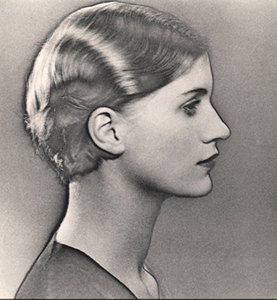Dal 7 febbraio e fino al 27 maggio alla National Portrait Gallery di Londra sarà possibile ammirare un’ampia retrospettiva dei ritratti fotografici di Man Ray, artista surrealista nato a Philadelphia nel 1980 e morto a Parigi nel 1976
Man Ray Portraits is the first major museum retrospective of this innovative and influential artist’s photographic portraits.
Focusing on his career in America and Paris between 1916 and 1968, the exhibition highlights Man Ray’s central position among the leading artists of the Dada and Surrealist movements and the significant range of contemporaries, celebrities, friends and lovers that he captured: from Marcel Duchamp and Pablo Picasso to Kiki de Montparnasse, Lee Miller and Catherine Deneuve.
Featuring over 150 vintage prints and key works from international museums and private collections, the exhibition also demonstrates Man Ray’s use of revolutionary photographic techniques and early experiments with colour, as well as surveying his published work in leading magazines such asVogue and Vanity Fair.
|
New York 1916-20
Born Michael Emmanuel Radnitzky in Philadelphia in 1890, Man Ray initially taught himself photography in order to reproduce his own works of art. In 1912 he began to change the signature on his paintings from ER to Man Ray, and the Radnitzky family adopted this shorter surname.
Man Ray’s earliest photographs date from around 1916, when he documented his own Dada self-portrait and made portraits of Marcel Duchamp. Man Ray’s support and promotion of avant-garde artists was formalised in 1920, when American patron Katherine Dreier invited Man Ray and Duchamp to establish the Société Anonyme, America’s first contemporary art collection. |
 Le Violon d’ingres Le Violon d’ingres
by Man Ray, 1924.
Museum Ludwig Cologne, Photography Collections (Collection Gruber) © Man Ray Trust / ADAGP © Copy Photograph Rheinisches Bildarchiv Köln |
|
Paris 1921-28
Despite Man Ray’s best efforts to promote Dada in New York, in 1921 he resolved to follow Duchamp to Paris where he expected his work to be better appreciated.
In December that year Man Ray held his first solo exhibition in Paris, Exposition Dada Man Ray. While critically well-received, the exhibition was not financially successful and he focused his artistic efforts on photography.
Man Ray established his first major studio in 1922 and in the following six years his important early works include two studies of his muse and lover Kiki (born Alice Prin), Violon d’Ingres and Noire et Blanche. |
 Solarised Portrait of Lee Miller Solarised Portrait of Lee Miller
by Man Ray, c.1929.
The Penrose Collection © Man Ray Trust/ADAGP, Paris and DACS, London 2012, courtesy The Penrose Collection. Image courtesy the Lee Miller Archives |
|
Paris 1929-37
One of Man Ray’s most important creative and personal collaborations was with the American-born photographer and fashion model Lee Miller, whom he first met in the summer of 1929, and together they developed the process of solarisation.
In 1934, with the editorial assistance of James Thrall Soby, Man Ray published a major collection of his photographic works. This was accompanied by a number of exhibitions including one at Lund Humphries Gallery, 12 Bedford Square, London.
Man Ray met Ady Fidelin in 1936 – a dancer from Guadeloupe who became the subject of many of his photographs. After the German invasion of France in 1940, Man Ray returned to the United States while Ady remained in France to stay near her family and safeguard many of his artworks. |
 Juliet with Brazilian Headdress Juliet with Brazilian Headdress
by Man Ray, 1945
The J. Paul Getty Museum, Los Angeles, 84.XM.1000.69 © Man Ray Trust ARS-ADAGP |
|
Hollywood 1940-50
Man Ray travelled to Hollywood where he met Juliet Browner, a 28-year-old dancer and artist’s model who had moved to California a year earlier. She became his muse and companion for the next thirty-six years.
During the next ten years, Man Ray was principally concerned with being a painter, but he continued to take occasional photographic portraits of friends and figures in the film and arts community. One of his last portraits made in Hollywood was a commission to photograph Ava Gardner in her role as Pandora in Albert Lewin’s film Pandora and the Flying Dutchman (1951). |
 Ava Gardner in costume for Albert Lewin’s Pandora and the Flying Dutchman Ava Gardner in costume for Albert Lewin’s Pandora and the Flying Dutchman
by Man Ray, 1950
Man Ray Trust © Man Ray Trust/ADAGP/DACS |
|
Paris 1951-76
Like other European artistic exiles who had gone to America during the War years, Man Ray returned to Paris in 1951. In June he moved into 2 bis rue Férou, which became his final studio and home for the next twenty-five years.
During this time, Man Ray was primarily concerned with making editions of his artwork, writing an autobiography Man Ray Self-Portrait (1963), and contributing to many retrospective exhibitions. However he experimented with new colour photographic processes, making colour portraits including those of Juliette Greco and Yves Montand.
In August 1976 Man Ray celebrated his eighty-sixth and last birthday, and was awarded the order of Artistic Merit by the French government. |


 Le Violon d’ingres
Le Violon d’ingres Solarised Portrait of Lee Miller
Solarised Portrait of Lee Miller Juliet with Brazilian Headdress
Juliet with Brazilian Headdress Ava Gardner in costume for Albert Lewin’s Pandora and the Flying Dutchman
Ava Gardner in costume for Albert Lewin’s Pandora and the Flying Dutchman

